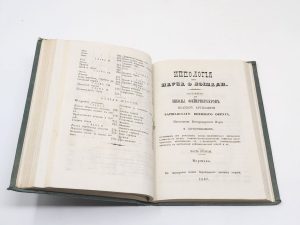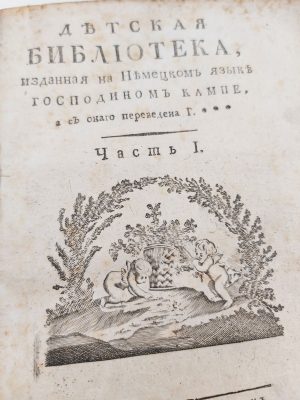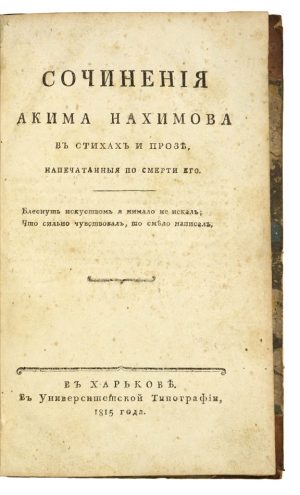Our Notes & References
“Teach not by beatings, threats or starvation, but by using only affectionate words”: first edition of this influential Russian work on horse education and hippiatry. Dedicated to Ivan Pankratievich Agafonov (1803-68), Privy Councillor and Warsaw Military District Medical Inspector.
The course was written specifically for veterinarian students of the Warsaw Military District, “for the Fireworks School of Field Artillery, by the master of veterinarian sciences of the Warsaw military district”, as indicated on the title page. Part I consists of 6 sections: 1) types of equine animals, horse breeds, famous horses in history, history of horses in Russia from Prince Vladimir to the 1860s, Russian horse breeds; 2) external characteristics of the horse; 3) internal anatomy of the horse; 4) bodily processes in healthy horses; 5) advice on preserving the horse’s health; 6) the art of horseshoeing.
Part II consists of 4 sections: 1) overview of equine illnesses; 2) remedies; 3) external and internal illnesses; 4) types of operations on the horse.
This relatively early work in the history of Russian hippology is a very good example of improvements in the veterinarian sciences in the Russian Empire under the reforms of Alexander II. In Chapter I, the author gives the following advice on the handling of the horse: ‘The intelligence of the horse, its memory and good nature allow us to teach it all those things that the man teaches to elephants and dogs. The horse can learn to solve puzzles, answer questions, say yes or no with its movements of the head, and with the stomping of its hooves indicate the hour, etc…. Whoever wants to teach the horse anything human should – at least at the beginning – to treat it like a human being, i.e. to teach it not by beatings, threats or starvation, but by using only affectionate words’ (our translation).
Skrinnikov’s work is illustrated by three fold-out plates, one showing the horse’s external appearance, with labelled parts, the second, the horse’s bones and the third, its muscle structure. It also includes a page of bibliography used for the book, quoting another of Skrinnikov’s work, and 14 other publications, mostly of the 1850s-60s.
Very rare: we were unable to trace this edition in Russian and Western libraries. Neither does it appear at auctions. The third, expanded, edition, published in Warsaw in 1883, is more common.
Physical Description
Two parts in one volume 8vo (20 x 14.3 cm). Title, dedication preface, short table of contents and bibliography, 278, [4] pp. table of contents; Title, 186, [6] pp. table of contents and errata list.
Binding
Contemporary green cloth with embossed gilt ornaments on spine and both covers.
Condition
Binding a bit scratched, especially the spine, boards stained, gilt partially lost; in lovely condition internally.






























